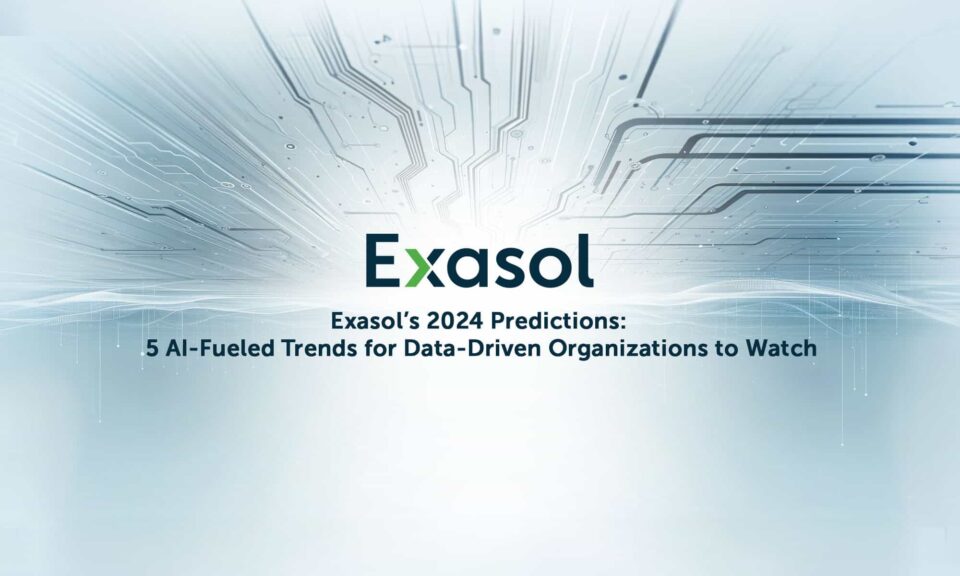
Exasol’s 2024 Predictions: 5 AI-Fueled Trends for Data-Driven Organizations to Watch

Another momentous year is coming to an end in the data analytics space. If I could sum up 2023 in one term, it would be “Artificial intelligence” (AI) because this year saw AI adoption explode, impacting every aspect of data analytics from automation and data silos to ethics and what we think of as traditional C-suite roles.
While there’s still a lot of uncertainty around how AI will continue to affect data analytics in the future, we put our heads together here at Exasol and identified the key trends we predict will impact the data analytics space in the year to come. From more shifts in AI, to growing data democratization initiatives and evolving C-suite roles and responsibilities, here are our top five predictions that data-driven organizations should keep in mind for 2024:
1. Shifting to more intentional AI: Unlocking opportunity while eliminating data collection-based roles
In 2023 we saw mostly “knee-jerk reactions” to the AI flurry from organizations that ultimately spawned countless poorly designed and executed automation experiments. Many of these failures were the result of businesses recklessly using third-party AI tools, increasing the risk of everything from failed projects to reputational damage, data breaches and financial and customer losses.
However, in 2024 we’ll start to see this AI approach shift away from being “reactionary” and towards something more “strategic.” This evolution will be rooted in purposeful proofs of concept that bring more clarity and focus to business objectives. As a result, we’ll begin to see more business benefit-driven use cases that make the most of AI and machine learning (ML).
You may also be wondering how ChatGPT plays into all of this. Well, we predict that generative AI will continue to merge with more traditional AI technology like descriptive or predictive analytics. As a result, new opportunities for organizations and streamlined processes will arise. And the same goes for merging AI with other technologies, like open source, that will continue to produce new models to solve traditional business problems.
When it comes to AI’s impact on jobs, it will continue to eliminate redundant job roles that involve high levels of repetition, data collection and data processing. Customer service, retail sales, manufacturing production and office support will likely be the most impacted by the end of 2024.
2. Data democratization advancements lead to more training on insights-driven skill sets
Until recently, access to data was typically limited to a select few within an organization, leading to data bottlenecks and silos. However, more businesses have begun to realize that to truly capitalize on all the information available to them, data must be accessible to everyone within the organization. In fact, a Harvard Business Review survey of industry leaders found that 97% believe organization-wide access to data and analytics is critical to the success of their business.
In 2024, we’ll see more organizations shift from just talking about data democratization to actually implementing it. More people, across various departments, will finally have access to meaningful insights, alleviating the traditional bottlenecks caused by data analytics teams. Without these silos, organizations will realize the even greater opportunity for their teams and individuals to leverage data, including those who don’t currently consider themselves data end users.
However, with this shift comes another major challenge, in that most of today’s teams aren’t equipped to ask the right questions of their data feed, or the automation powering it. As a result, they’ll need to be trained on the right skills to effectively use data and insights to make business decisions.
3. AI backlash: Organizations will waste more time and money trying to ‘get it right’ in 2024
Experimentation will remain a key theme for AI throughout the first half of 2024 as organizations strive to become more strategic with their automation-driven initiatives. That means more time and money spent on AI.
I’ve found that many of the teams that are responsible for AI implementation have been conditioned to lead with a “try fast, fail fast” mindset. But along the way, they often lose sight of the variables they’re targeting and the expected outcomes, and they struggle to ask the right questions of AI. We’ll see that the most successful organizations will fail fast and quickly rebound from the lessons they learned. Enterprises should anticipate spending extra time and money on AI experimentation, given that most of these practices aren’t rooted in a scientific approach. Indeed, some projections show that global spending on AI will more than double by 2026.
There’s always a flurry of questions that follow the emergence of any new technologies, and we’ll continue to see them arise around the data fueling AI’s potential, including questions about whether or not “clean data” is being used, and about the legal rights and ethics around that data over the next year.
4. FinOps will be prioritized as CIOs navigate cost-savings
CFO and CIO roles have evolved greatly over the last few years of economic uncertainty as cloud adoption increased. Last year, we predicted that CFOs would become more cloud-savvy amidst recession fears to ensure that their organizations were making the right deployment and financial decisions when it comes to the cloud, at a time where every penny counts.
This trend will continue into 2024 as FinOps practices the financial governance of cloud IT operations. We’ll see businesses try to prevent unpredictable and chaotic cloud spend and gain assurance from the CIO that cloud investments are aligned with business objectives.
At the end of the day, the ability to save on cloud costs is a great opportunity for the CIO. We’ll see price/performance come to the forefront of important metrics for achieving this goal, as it provides a great way of gauging resource efficiency in the data tech stack. Further, since most FinOps practices are still in their early stages, we predict that CIOs will spearhead these efforts and start to perform regular price/performance reviews.
This will also become increasingly critical for organizations reporting on ESG and sustainability initiatives. FinOps practices will be integral to driving carbon efficiencies to align with organizations’ sustainability goals.
5. AI governance pressure builds for the C-suite
Many of today’s data and analytics teams already lack the time and resources to keep pace with data governance needs, especially as pressure grows to reduce operational costs. If a company falls victim to poor data governance practices, they risk compromising their data quality, along with the security of their data and regulatory compliance with a growing number of data privacy and protection laws. Gartner reports that poor data quality costs organizations an average $12.9 million every year.
The emergence of AI has only added more complexity and urgency to the situation. In 2024, we’ll see the practice of AI governance become a C-level imperative as businesses try to take full advantage of the game-changing opportunities it presents while balancing responsible and compliant use.
Effective AI governance requires collaboration across functions to address its ethical, legal, social, and operational implications, but the responsibility ultimately rests squarely on the CDOs’ shoulders. The introduction of new AI regulations and the evolving regulatory landscape will push some CDOs to their breaking point. For others, it will underscore the importance of establishing a fully-resourced AI governance capability, coupled with C-level oversight. This strategic approach not only addresses immediate challenges, but also strengthens the overall case for proactive and well-supported AI governance going forward.
There’s no way to know for certain what 2024 will hold in the data analytics space. But keeping these trends in mind can help better inform your data-driven strategies and drive maximum value from your data. As the year comes to a close, now is the time to get ahead of these market-drivers and invest in the right data management and analytics tools for your business needs.
To learn more about how Exasol can help businesses increase productivity, cost-savings and flexibility to redefine how they use data – on their own terms, without having to compromise – click here.
We wish you a happy holidays from our team here at Exasol, and a healthy new year!





